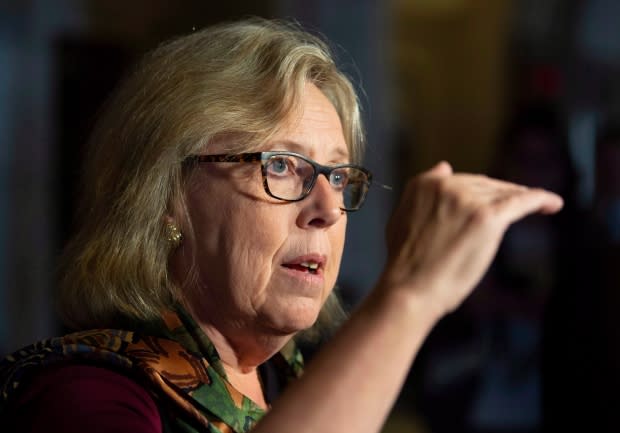Liberal concessions on the environment leave the Greens and NDP battling for climate-motivated voters
This column is part of a CBC News series entitled In Our Backyard, which looks at the effects climate change is having in Canada, from extreme weather events to how it's reshaping our economy.
The climate crisis will be a major issue in the upcoming election, and the NDP and Greens will be jousting to own the file.
Conservative leader Andrew Scheer, who has promised to scrap the carbon tax, probably won't be the top choice for anyone who considers the environment a priority, and Prime Minister Justin Trudeau has alienated many progressive voters with his government's carve-outs for industry and $4.5 billion purchase of the Trans Mountain pipeline.
With more than 80 per cent of Liberal, NDP, and Green voters saying climate is "top five" issue in the fall election, the Liberals' weakness presents the NDP and Greens with an opportunity to tap climate-motivated voters. Both parties are presenting bold plans to rapidly reduce emissions, but NDP leader Jagmeet Singh has so far failed to gain traction, and the Greens will face heightened scrutiny as the election comes closer.
Where carbon pricing once dominated the policy discussion, it appears many centre-left voters in Canada — influenced by discussions catalyzed by the Green New Deal in the U.S. — have become more open to radical plans for public investment to drive the transition away from fossil fuels and create good-paying jobs.
New emissions targets
The Liberals have held firm on carbon pricing, despite the parliamentary budget officer saying the tax would have to double to hit our Paris targets, but the NDP and Greens' new plans are clearly inspired by what's happening south of the border. The NDP's "new deal for climate action and good jobs" pledges a 38 per cent cut in emissions, exceeding the Liberals' 30 per cent, while the Greens' "Mission Possible" commits to a much more ambitious 60 per cent reduction by 2030.
Both plans maintain carbon pricing, but they're supplemented with programs that they say will create hundreds of thousands of jobs retrofitting homes, installing renewable energy, expanding public transit, and doing other work to reduce emissions. The NDP is a more natural party to push this vision because of its longstanding relationship with labour, but the Greens gain the upper hand politically.

The NDP has struggled since Singh took over as leader, currently sitting around 15 per cent support (almost five points below its 2015 result), and his presence in Parliament hasn't made much of a difference. Even though the NDP's plan is impressive in its commitment to create 300,000 jobs, expand access to employment insurance, and invest in transit, trains, and rural buses, it's unclear whether Singh can effectively sell these ambitious proposals to Canadians.
The Greens, meanwhile, have momentum. They've picked up seats in four provincial legislatures, a second federal seat, their poll numbers have risen to nearly 11 per cent, and leader Elizabeth May has the highest approval rating among her federal peers. However, this attention will come with scrutiny, and it's not yet clear that their plan will hold up.
The Greens are making bold, but vague proposals that will need to be further detailed before the election. The plank that has received the most attention is their call to end foreign oil imports, a policy shared by the Conservatives, but it doesn't seem fully thought out. May claims her plan won't require a pipeline to the East coast — the Conservatives and Liberals disagree — and when 64 per cent of Canada's oil imports come from the U.S., compared to just 18 per cent from Saudi Arabia, it's hard to argue this is about "ethical" oil.
The Greens have a natural appeal to environmentalists, but focusing so much on oil to appeal to a wider range of voters could hurt them with their base. Yet if outright opposition to fossil fuels is a prerequisite for some voters, they may not have a home at all, as Singh has evaded questions on B.C.'s LNG development, which depends on fracked gas.
Winning over progressive voters
Whether the NDP or Greens are able to carve off more Liberal voters may depend on where their political allegiances lie. Voters with a stronger identification with the working class — those who voted Liberal in 2015 to oust Prime Minister Stephen Harper — may be more drawn to the NDP's labour-centred vision for the green transition.
By contrast, more natural Liberal supporters could feel drawn to the Greens because, though they support expansion of social programs, including single-payer pharmacare, like the NDP, they are more open to market-oriented solutions like using taxation to drive behaviour, even though consumption taxes disproportionately hit people with lower incomes.
The Greens appear to be in the perfect position to capitalize on climate concern and Liberal disillusionment, but it's worth remembering that this time four years ago, people were starting to seriously talk about the NDP forming federal government — and we know how that turned out. Is Canada about to see a Green wave and a new third-place party, or will Singh's "New Deal for the People" finally help him connect with voters? At this point, anything could still happen.
This column is part of CBC's Opinion section. For more information about this section, please read our FAQ.

